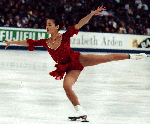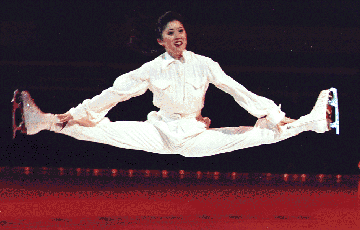Jumps
There are six major jumps in singles skating,
ie. Axel, Salchow, Toe Loop, Loop, Flip, and Lutz. All the six major jumps
are landed on a strong back outside edge. Jumps can be performed as individual
jumps or as jump combination. There are two kinds of jumps, ie. edge jumps
and toe jumps. The latter are jumps taking off with toe-assist from the
freeleg.
There are two positions for the jumps in mid-air.
Both are spinning positions --- legs crossed, left leg across right leg
for CCW skaters, arms folded in with the hand in front of the chest (may
or may not be clenched). The difference is that one position have the elbows
out to the side while the other have the elbows down, touching the sides
of the body near the hips. Both positions are however as effective.
Jump combinations can be done with two sequences : -
<jump> + toe loop
<jump> + loop
 This is the position
of the landing of any of the six major jumps. The photo shows Michelle
Kwan's landing of a jump --- a strongly checked, back outside edge. For
aesthetic purposes, the free leg is lifted high, arms and head up!
This is the position
of the landing of any of the six major jumps. The photo shows Michelle
Kwan's landing of a jump --- a strongly checked, back outside edge. For
aesthetic purposes, the free leg is lifted high, arms and head up!
Photo by J. Barry
Mittan
Axel
The axel is the most difficult jump of all the six major jumps,
named after its inventor, Axel Paulsen. At the moment no one has ever landed
a quadruple axel in competitions yet, though some has landed the quad axel
in practices. This is the only major jump that is approached with a forward
edge. A single axel is actually one and one-half revolution.
The entry for the axel is a forward outside edge. A skater will first
skate on backward crossovers and from a right back outside edge, he will
step forward to a left forward outside edge. After the set up, the skater
has to bend the skating leg and lean slightly forward with the left shoulder
leading, arms down and back. The leading of the left shoulder must be emphasized
as it sets the hips at the right position for maximum angular momentum
for the rotation in the air later. If the shoulders are square, ie. hips
closed, most likely, the skater will not be able to give a full one and
one-half rotation for the jump. The freeleg can be slightly bent or straight
but the knee of the freeleg is never locked.
Next the skater will leap up in the air and kick his freeleg forward.
The arms moves from down up, then pulled in. With proper technique, the
legs should be automatically cross to the desirable position. Next comes
the landing.
Variations of the Axel Paulsen : -
Open axel - axel with a rather open position, less rotation done.
Inside axel - leap from a LFI, 1.5 rotation, land on a RBO.
One foot axel - similar to the normal axel except landed with a LBI.
Delayed axel - longer hold of the waltz jump position after the leap, faster
rotation at the end of the jump.
Reverse delayed axel - unravel spinning position after one rotation, faster
rotation at the beginning of the jump.
Tuck axel - axel with both leg bent (like a squatting position).
Cross tuck axel -axel with both legs bent and crossed.
Russian split axel - leap up into a Russian split, then assume the spinning
position to complete the rotation for the axel.
Salchow
Salchow is an edge jump taking off from a backward inside edge.
The usual set up for this jump is a shallow but strongly checked 3-turn.
For CCW skaters, the 3-turn is done on the LFO. After the turn the skater
should reach a LBI. At this point the correct position is the left arm
forward, right arm to the side and freeleg back pointing downwards.
The take off starts by a deepening of the LBI edge. This is done by
bending the left knee and reaching the right knee forward. The skater then
leaps into the air and the right foot reaching out like a waltz jump. The
process of reaching the knee forward should be a straight path but some
skaters do it in a wide arc. After the leap, the skater should assume the
spinning position. For single salchow however, the position is much more
open and the arms can be held further away from the chest.
Toe Loop
The toe loop is a toe-assisted jump taking off from a back outside
edge. The quaduple toe loop has been consistently landed by Elvis Stojko
in competitions. This jump can be performed as an individual jump or as
a second jump in a jump combination.
CCW skaters can approach this jump in a few ways. One way is by doing
a RFI 3-turn into a RBO. Another method is a LFO 3-turn, step on a RBI
and a switsh of edge to a RBO. At this position the left arm should be
held at the front and right arm slightly to the back. From the RBO, the
skater will place his left toe-pick down on the ice and leap off the RBO
propelled backwards with the assistance of the toe-pick.
A similar jump, taking off from a RBI edge with toe-assist is called the
toe walley.
Variation on the toe loop : -
Mazurka - RBO open hip position left hand back, right hand forward.
Lower left toe-pick and jump up. Cross both feet in the air
in a scissoring motion. Land on right toe, push on a LFO or LFI.
Loop
The loop jumps is an edge jump taking off from a backward outside
edge. This jump can also be performed as an individual jump or as a second
jump in a jump combination.
There are various set ups for the loop jump. The most popular is a left
inside drop mohawk and a step onto a RBO. Another popular method is by
doing a RFI 3-turn. Before the leap, the left leg should be slightly crossed
in front of the right leg with minimal tracing done on ice. This is achieve
by the skater shifting his weight to the right foot. Left arm held to the
front and right arm back.
The leap is done by deepening of the RBO edge, by bending on the right
leg. There should not be much problem assuming the spinning position as
the body is already in the position before the jump.
A similar jump as the loop taking off from the LFI is called the walley.
The method of execution of the walley, however, differs from the loop.
Variation on the loop : -
Open loop - loop executed in a rather open position.
Half loop - despite its name the jump is actually a full one rotation,
landing on a back inside edge.
Flip
The flip is a toe-assisted jump taking off from a back inside
edge. There are two common set ups for this jump. One is the right mohawk
set up and the other is a LFO 3-turn set up, both resulting in a LBI..
At this stage the skater should have his left arm out to the front and
right arm back.
The jump is done by leaping off the LBI edge and at the same time, placing
the right toe-pick on the ice. The toe pick will assist the jump by hauling
the skaters back.
Variation on the flip : -
Delayed flip - left leg pulls back in a wide arc at the moment of the
leap instead of crossing it to the front of the right leg.
Lutz
The lutz, named after Alois Lutz, is a unique toe-assisted jump
as it involves a counter rotation. In the first five jumps discussed earlier(except
the toe walley), the rotation of the jumps are done in the same direction
as the skating direction. The tracing done on ice is therefore an 'S' shape.
In the case of a lutz, the rotation of the jump is the reverse of the skating
direction. Skated in a LBO, left arm forward and right arm back, a CCW
skater places his toe-pick on the ice and leaps like the flip. It is to
be noted that the take off edge should not change into a LBI edge. As the
rotation (counter clockwise) is different from the skating direction (clockwise),
the jump will feel awkward initially.
Variations on the lutz : -
Tano lutz - Brian Boitano's signature jump - lutz with the left arm
reaching up (instead of folding it infront of the chest).
Reverse lutz - same takeoff, land on left toe pick, push off a RFO. 'O'
shape tracing on ice.
Toeless lutz - lutz done without the help of the freeleg toe-pick. Rarely
done.
Waltz jump
The waltz jump is a minor jump of one-half revolution only.
The take off is similar to the axel. The position in air is not the spinning
position but a side split position with arms held forward. Landed on a
back outside edge. This jump can be a breathtaking sight if done at great
height as it gives both spectators and skaters a feel of "suspension"
in the air.
Splits
Splits can be executed in one-half revolution or one revolution.
The different kinds of splits are :-
Split jump - takeoff like the flip, one-half rotation of front split
position, land on left toe, push off a RFI.
Russian split jump - takeoff like the flip, one-half rotation of side split
position, land like a split jump.
Split flip - performed like the split jump, one revolution, land on RBO.
Russian split flip - performed like the Russian split jump, one revolution,
land on RBO.
Split lutz - lutz takeoff, one rotation of front split position, land on
RBO.
Russian split lutz - similar to the split lutz except that a side split
position is done. The more dramatic of the splits.
Stag jump - split jump takeoff and landing, left leg bent and knee lifted
up, right leg straight (CCW position). More showy.
Bourkey jump - like a stag jump but the right leg bent instead of left,
right ankle lifted up, ie. foot facing forward.
Split falling leaf - RBI takeoff for CCW, one-half rotation of front split
position, landed like a split jump.


*For media clips on the jumps please visit Technical
Skating, a page managed by Kevin Anderson.
Photo by J. Barry
Mittan
Proceed to ...
Singles skating
The Axel Paulsen main page
Additional materials : -
Jump
Physics - the science behind jumps rotations. Read this to increase
chances to land the triple axel!
 Direct
all comments to me at paulsen@oocities.com
Direct
all comments to me at paulsen@oocities.com
Updated 12-26-96
HL Matthew Lee
paulsen@oocities.com
 This is the position
of the landing of any of the six major jumps. The photo shows Michelle
Kwan's landing of a jump --- a strongly checked, back outside edge. For
aesthetic purposes, the free leg is lifted high, arms and head up!
This is the position
of the landing of any of the six major jumps. The photo shows Michelle
Kwan's landing of a jump --- a strongly checked, back outside edge. For
aesthetic purposes, the free leg is lifted high, arms and head up!
